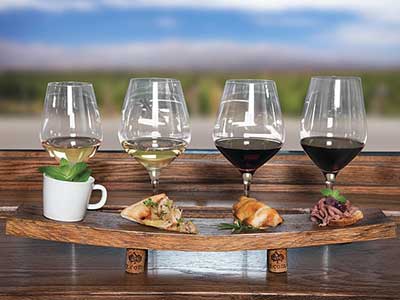Between cheese, poultry, meat, fruit, beans, fish and all the other foods that are supposed to show up on the table with a bottle of wine, how can we to begin to know how to pair the right kind of wine with the right kind of food and vice versa?
The possible combinations seem endless, and at first glance, one might think that pairing food and wine is hard to do. Fortunately, it isn’t all that difficult when you get down to it. With a little know-how, you can match them with confidence.

Wine Amplifies Foods’ Flavours
Lots of classic pairings involve foods with strong-tasting fats like beef, pork, cheese and fish. This is no coincidence. When you eat fatty foods, they coat your tongue and render it less able to taste other things, but the acid in wine dissolves that fat and lets you taste the food more intensely. This is what is called ‘clearing your palate’. Some people feel trepidation about drinking something highly acidic, but in this case, you want a bright, acidic wine!
In the same vein, tannins and similar compounds abundant in red wines are especially good at clearing your palate after you eat meat. They also happen to have flavours that are complementary. This is why pairing red wines with red meats is a classic choice.
Pair Like with Like
The heavy, woody flavours of dry (meaning not sweet) red wines pair well with red meats. On the other end of the spectrum, bright, tangy white and rose wines go well with tart flavours like fruit, salad, and sauces based on vinegar or citrus. Dry whites complement fish and pork for similar reasons.
Don’t Overwhelm
Flavour intensity is almost as important as content, because an extremely strong-tasting wine will overload your taste buds and render what you’re eating bland and comparatively uninteresting. Strong foods will do the same to weak-tasting wines. Pair strong tasting foods with bold wines and mild food with delicate wines.
Location Matters
Wine and cuisine have evolved side by side throughout history, and the best wine pairings reflect that. For example, French foods, whether they call for white or red wines, will pair best with French wines. The reason why is simple: winemakers chose grapes and growing methods that would sell well, and wines that sold well went best with the food locals were eating!
To be sure, there are more nuances, exceptions, and even basic rules that we couldn’t cover here, but if you keep these four essential tips in mind, you’ll never make a bad wine pairing again. Now, whether you’re looking to quickly choose a wine to serve at your next party or you have a bottle in storage that you need to pair, you’ll be on track.
Whether you want to be part of the hospitality industry or just learn the basics of alcohol service, don’t forget: we offer quick, reasonably priced and frequent RSA courses in Melbourne.




